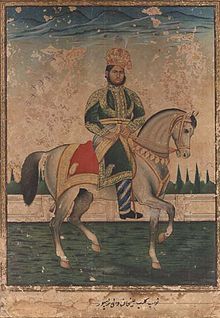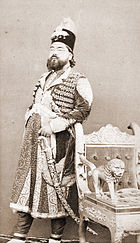This article has multiple issues. Please help improve it or discuss these issues on the talk page. (Learn how and when to remove these messages)
|
State of Rampur Dar-Ul-Insha دارالانشا | |||||||||||||
|---|---|---|---|---|---|---|---|---|---|---|---|---|---|
| 1774–1947 | |||||||||||||
| Motto: "الحكم لله والملك لله" "Al Hukumu Lillah Wāl Mulk Lillah" .Lā Fata ʾIllā ʿAlī; Lā Sayf ʾIllā Ḏū l-Fiqār. | |||||||||||||
 Rampur State in yellow | |||||||||||||
| Status | 15 gun-salute princely state | ||||||||||||
| Capital | Rampur | ||||||||||||
| Official languages | |||||||||||||
| Other languages | |||||||||||||
| Religion |
| ||||||||||||
| Demonym(s) | Rampuri | ||||||||||||
| Government | Absolute monarchy | ||||||||||||
| Nawab | |||||||||||||
• 1774–1794 | Faizullah Khan (First) | ||||||||||||
• 1794 | Muhammad Ali Khan | ||||||||||||
• 1794 | Ghulam Muhammad Khan | ||||||||||||
• 1794–1840 | Ahmad Ali Khan | ||||||||||||
• 1930–1947/1956 | Raza Ali Khan (Last) | ||||||||||||
| History | |||||||||||||
| 7 October, 1774 | |||||||||||||
| 15 August, 1947 | |||||||||||||
| Area | |||||||||||||
• Total | 2,447.54 km2 (945.00 sq mi) (1st; princely state) | ||||||||||||
• Water (%) | 1 | ||||||||||||
| Population | |||||||||||||
• Estimate | 546,151 | ||||||||||||
• Census | 1901 | ||||||||||||
| Time zone | UTC+5:30 | ||||||||||||
| Drives on | left lane | ||||||||||||
| |||||||||||||
| Today part of | Uttar Pradesh, India | ||||||||||||




Rampur State was a 15 gun-salute princely state of British India. It came into existence on 7 October 1774 as a result of a treaty with Oudh. Following independence in 1947, Rampur State and other princely states of the area, such as Benares and Tehri Garhwal were merged into the United Provinces.[citation needed] Rampur state had its capital in Rampur city and its total area was 945 sq miles.[1] Rampur state was founded by Ali Mohammad Khan's younger son Faizullah Khan.[2][3][4][5]
The Jama Masjid is one of the finest piece of architecture to be found in Rampur. It resembles the Jama Masjid in Delhi to some extent.[original research?] It was built by Nawab Faizullah Khan. It has a unique Mughal touch to it. There are several entry-exit gates to the masjid. It has three big domes and four tall minarets with gold pinnacles boasting of a royal touch. It has a main lofty entrance gate that has an inbuilt clock tower occupied by a big clock that was imported from Britain.
There are several entry-exit gates built by the Nawab. These gates are major entry-exit routes from the city. Examples are Shahabad Gate, Nawab Gate, Bilaspur Gate etc.
- ^ Hunter, William Wilson (1881). The imperial gazetteer of India. India: Trübner & Company. pp. 544–546. Retrieved 16 December 2013.
Rampur state.
- ^ Wade, Bonnie C. (1984). Khyal: Creativity Within North India's Classical Music Tradition. CUP Archive. ISBN 978-0-521-25659-9.
- ^ The Indian Year Book. Bennett, Coleman & Company. 1945.
- ^ The Indian and Pakistan Year Book. Bennett, Coleman & Company. 1929.
- ^ Ashraf, Mujeeb (1982). Muslim Attitudes Towards British Rule and Western Culture in India in the First Half of the Nineteenth Century. Idarah-i Adabiyat-i Delli.

